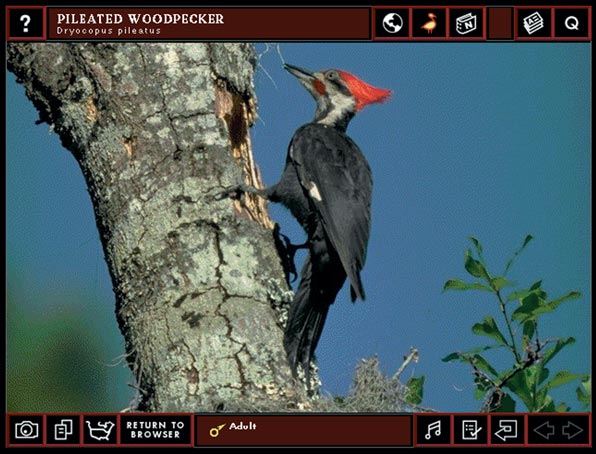
This Article From Issue
May-June 1998
Volume 86, Number 3
DOI: 10.1511/1998.25.0
National Audubon Society Interactive CD-ROM Guide to North American Birds. For Windows and Macintosh computers. Alfred A. Knopf, Inc., 1996. $56.95.
I took a close look at the bright-red crest and the zigzagging white line that stretched across a male pileated woodpecker's face. Then I listened over and over to its call—a rather high-pitched kik-kik-kikkik. After calling, the bird drummed his beak against a tree, no doubt starting to make one of its notably oblong holes. Surprisingly, I enjoyed this educational encounter without leaving my house. And I wasn't flipping through a field guide or running a bird-call tape back and forth over and over. Instead, I merely pointed and clicked my way around a CD-ROM.

From the National Audubon Society Interactive CD-ROM Guide to North American Birds.
With the National Audubon Society Interactive CD-ROM Guide to North American Birds, I can "observe" 723 species, seeing each in several different photographs. Beyond simply seeing the birds, this CD-ROM lets me hear their calls, see maps of their ranges and read about their behavior. If I like, I can also use this product to keep track of my life list—all of the birds that I have actually seen in nature.
The day after I received this package, my wife and I took a walk down the quiet road that runs beside our house. About a mile from home, a bird rustled a branch and caught my attention. A little glimpse of the bird brought a mockingbird to mind. That identification felt close, but wrong. So I stopped and hoped the bird would move out from behind a clump of leaves. Then the bird hopped to a branch in the open, giving me a good look at its profile. Although I hadn't seen that bird in many years, I immediately whispered its name—yellow-billed cuckoo. As soon as I got back to our house, I cranked up this CD-ROM and located the cuckoo. Although the information confirmed my identification, the photographs disappointed me, because none of them showed one of this bird's most distinguishing field marks—the large white spots on the underside of its tail. Then I hit the button that played the cuckoo's call, and I recognized it. This species had been calling high up in the trees around my yard for the past few years, but I had never been able to identify who was making that hoarse-sounding noise.
Nevertheless, this CD-ROM cannot solve all bird-call mysteries. For example, I might not recognize the rufous-sided towhee from its limited call given on this product, because it omits the common drink-your-teeeee. And the call for the American woodcock includes its nasal-sounding notes along with the chirpy noise that it makes with its wings during the downward portion of its courtship flights, but a user may need to read all of the accompanying text to figure out which is which. Such shortcomings, however, apply to most other sources of bird-call information. To really understand a bird's call, I go to the field.
Although the field-guide features alone would attract me to this product, it offers even more. In an area called "About Birds," a user can watch five QuickTime videos that cover anatomy, evolution, flight, migration and reproduction. In the flight essay, for instance, viewers learn about aerodynamic phenomena, including lift and stall. That essay also reveals the differences between gliding, hovering, soaring and more.
This CD-ROM also offers other useful features. A trip planner makes suggestions for some great birding spots, but seasoned birders will know of nearly all the places mentioned. A skill-builders section lets users match birds with their songs in a clock-battling environment. That matching game should be helpful for beginners and fun for nearly all birders. Another section on this CD-ROM even walks a beginner through the basics of binoculars.
Even after nearly 20 years of amateur birding, I learned many new things after a few tours through this CD. I find myself turning to it to identify an unknown species or just to brush up on a few birds that I haven't seen lately. Either way, I always enjoy the trip.—Mike May
American Scientist Comments and Discussion
To discuss our articles or comment on them, please share them and tag American Scientist on social media platforms. Here are links to our profiles on Twitter, Facebook, and LinkedIn.
If we re-share your post, we will moderate comments/discussion following our comments policy.